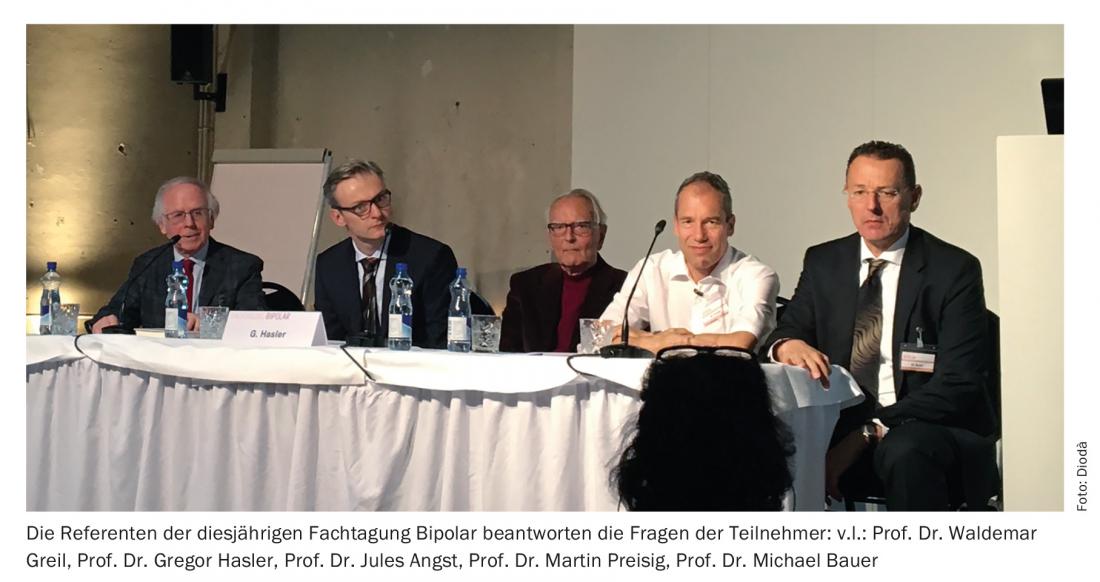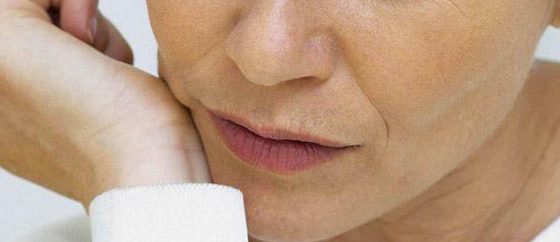Bipolar disorder has many faces. These are clinically relevant because they influence response to drug and psychosocial treatments. When bipolar disorder is actually present, how it is differentiated from other disorders, and where transitions exist cannot always be answered right away. In the DSM-5, new criteria apply in some cases and these have implications for treating physicians. At this year’s Bipolar Symposium, entitled “Forms of Bipolarity – from Cyclothymia to Mixed Specifier”, renowned experts explained their findings on the complex interrelationships in this disorder.
Similarities and differences in the treatment of unipolar and bipolar disorders were the focus of the presentation by Prof. Michael Bauer, Director of the Clinic and Polyclinic for Psychiatry and Psychotherapy at the Carl Gustav Carus University Hospital in Dresden. Both disorders have a high, lifelong risk of recurrence and a 20-fold increased risk of suicide compared to the normal population. There is a high comorbidity with cardiovascular disease, anxiety and addictive disorders, and life expectancy is shortened by about ten years.
Proper relapse prophylaxis is crucial
Differences exist in epidemiology, MDD is more common than bipolar disorder, in gender distribution, women are more likely to be unipolar, while there are no significant differences in bipolar. Heritability is greater in bipolar disorder and first illnesses occur earlier than in MDD.
In both diseases, a distinction is made in drug treatment between acute therapy, maintenance therapy (in the first six months after an acute episode has subsided) and phase prophylactic therapy (relapse prophylaxis). Proper relapse prophylaxis is important to prevent relapses in the long term and to ensure that patients can lead as normal a life as possible. For unipolar depression, first-line antidepressants that have worked in the acute phase are used for this purpose. In bipolar disorders, these include, in particular, lithium, quetiapine, and, as adjunctive treatment, antidepressants and lamotrigine.
Cyclothymia, Bipolar-II and Bipolar-I in times of DSM-5.
Prof. Jules Angst, Professor Emeritus of Psychiatry, Psychiatric University Hospital Zurich, explained in his presentation that cyclothyme disorder seems to have little practical relevance because of its rarity. From DSM-IV to DSM-5, the proportion of bipolar disorders increases significantly at the expense of pure depression (MDD). This is mainly because of the inclusion of hypomanic episodes under antidepressants. The new group of cyclothyme disorder requires more days with hypomanic or depressive symptoms over two years than not. This form of chronicity is rarely fulfilled (1 in 48 pure minor bipolar patients), so that no conclusions can be drawn about it from the data of the prospective epidemiological Zurich study from age 20 to 50.
Manias are too narrowly defined
Further, Prof. Angst explained that manias are too narrowly defined in the DSM-5. This because new all must have increased activity/energy as the dominant symptom. This causes some previous DSM-IV Bipolar-I sufferers to be diagnosed as pure depression, which seems scientifically unjustified. Furthermore, according to DSM-5, individuals who had a full manic symptom picture in addition to MDD or would be treated for hypomanic syndromes or complained of social consequences are defined as having Bipolar II disorder. The DSM-5 diagnosis results in a prevalence of 24.2% MDD, 1.2% BP-I and 0.6% BP-II in the Zurich study. Bipolarity is clearly underestimated. The modified diagnosis proposed by Prof. Angst yields 18.2% MDD, 2.7% BP-I, and 6.5% BP-II.
One-third of major affective disorder is bipolar
The two modified bipolar groups are far more strongly associated with somatic and psychiatric syndromes than MDD. BP-I is characterized by significant associations with obesity, bulimia/binge, hypertension, cardio-vascular disorders, migraine/tension headache, specific phobia, and obsessive-compulsive disorder compared with BP-II. BP-II disorders have significantly higher associations with hypertension, back pain, smoking, alcohol abuse, and suicide attempts compared with BP-I. The conclusion of Prof. Angst is: From the age of 20 to 50, about one third of severe affective disorders can be diagnosed as bipolar and accordingly treated prophylactically, mainly with lithium, in the long term. This could reduce cardiac mortality and the risk of suicide and dementia.
Schizoaffective disorder: a form of bipolarity?
The ICD-10 typology of schizoaffective disorder distinguishes between schizoaffective disorder, currently manic, schizoaffective disorder, currently depressive, and mixed schizoaffective disorder. This is a typology according to cross-sectional findings without taking into account the long-term course, said Martin Preisig, head of the research department for psychiatric epidemiology and psychopathology at the Psychiatric University Hospital Lausanne in his presentation.
The speaker explained the diagnosis of schizoaffective disorder and commented on the criteria as follows: Criterion A is a continuous period of illness during which a major mood episode coexists with symptoms that meet Criterion A for schizophrenia. But the condition of simultaneity is controversial. The presence of affective episodes and psychotic symptoms longitudinally should suffice. The requirement that psychotic symptoms be present to meet the criterion of schizophrenia is also controversial. The presence of psychotic symptoms should be sufficient. According to criterion B, delusional phenomena or hallucinations have been present for at least two weeks during the course of the illness in the simultaneous absence of pronounced affective symptoms. The modified criterion, Prof. Preisig said, took into account criticism from those who called for a longitudinal definition. Criterion C of the diagnosis of schizoaffective disorder is: symptoms meeting criteria for an affective episode persist for more than half of the total duration of the florid and residual periods of the illness. Here, the presenter noted that the modified criterion helped clarify the required affective component of the disorder but raised the threshold for a diagnosis of schizoaffective disorder. (Numerous schizoaffective disorders according to DSM-IV are reclassified as schizophrenias).
Characteristics, diagnosis and treatment in schizoaffective patients.
Regarding the characteristics of schizoaffective patients compared with schizophrenic and bipolar patients, a meta-analysis found that most demographic, clinical, and psycho-metric characteristics of schizoaffective patients were intermediate between those of schizophrenics and bipolars. However, in seven of nine demographic and clinical characteristics and in five of eight psychometric measures, schizoaffectives were closer to schizophrenics than to bipolars. For long-term treatment, the scientific evidence for the prophylactic effect of the various substances tested is limited. Nevertheless, the data encourage treatment of predominantly affective schizoaffectives by lithium and carbamazepine and treatment of predominantly schizophrenic schizoaffectives by clozapine.
When making a diagnosis with regard to treatment, it seems useful to distinguish bipolar from unipolar disorder according to the long-term course. The high threshold for the diagnosis of schizoaffective disorder in terms of the proportion of affective symptomatology seems particularly problematic for bipolar schizoaffective disorder. Regarding treatment, Prof. Preisig commented as follows: In bipolar schizoaffective disorder, atypical neuroleptics with or without mood stabilizers are used. In unipolar schizoaffective disorder, it is atypical neuroleptics for long-term treatment in combination with antidepressants during depressive episodes.
Drug safety with Mood Stabilizer
Prof. Waldemar Greil, Scientific Advisory Board, Kilchberg Sanatorium, visiting scientist at the Psychiatric Clinic of Ludwig-Maximilians-University Munich, set his presentation against the background that polypharmacy with more than three different psychotropic medications has increased significantly over the last 20 years. This is shown by data from the AMSP (drug safety in psychiatry) project. Mood stabilizing agents (mood stabilizers) such as lithium, valproate, lamotrigine, and quetiapine – are recommended in all guidelines as agents of choice for bipolar disorder. In therapeutic practice, antidepressants and benzodiazepines also play a major role, but they are not usually indicated. Another problem is the frequent use of valproate in women of childbearing age, which many medical societies strongly warn against.
Adverse drug reactions
The AMSP project also examines adverse drug reactions (ADRs) to prescribed medications. With anticonvulsants, the most common serious ADRs are dermatologic, followed by hyponatremia and, less frequently, hematologic ADRs, weight gain, and liver elevation. Pronounced skin reactions are most common with lamotrigine and carbamazepine, hair loss almost exclusively with valproate, and hyponatremia and hematologic disturbances more common with carbamazepine. During therapy with anticonvulsants, appropriate laboratory controls must be performed in a targeted manner. With lithium, serum calcium should be determined in addition to lithium levels and renal and thyroid values to detect hyperparathyroidism early. Prof. Greil recommends not prescribing “interaction-friendly” drugs if possible. Critical interactions have emerged from the evaluation of AMSP data primarily for: Carbamezepine, St. John’s Wort, Midazolam, Moclobemide, Paroxetine as well as for Clozapine, Fluvoxamine, but also for Lithium (a drug that is urgently needed).
Plan back prescriptions
Given the prevalence of polypharmacy – also known as polypharmacotherapy – it is important to consider with patients whether deprescribing is an option, the speaker said. Such a reverse prescription involves five steps: 1. create a comprehensive list of medications, 2. identify potentially inadequate medication, 3. Establish medication and priority sequence of discontinuation, 4. create and initiate weaning plan and 5. control, support, documentation. It is important to consider potential problems of discontinuation: Withdrawal symptoms, rebound, and relapse. Very careful, gradual weaning is strongly advised. In individual cases, it was described that lithium was no longer sufficiently effective as a prophylactic after discontinuation and subsequent restart. However, this could not be confirmed in a meta-analysis.
Source: 12th Annual Interdisciplinary Meeting of the Swiss Society for Bipolar Disorders SGBS, November 5, 2016, Zurich.
InFo NEUROLOGY & PSYCHIATRY 2016; 14(6): 54-56.












